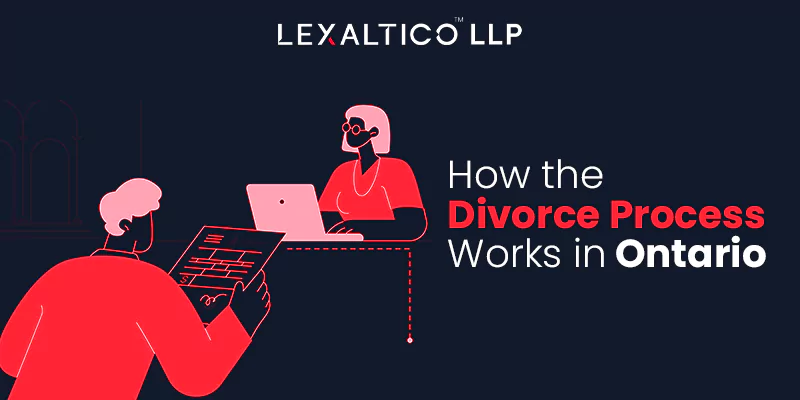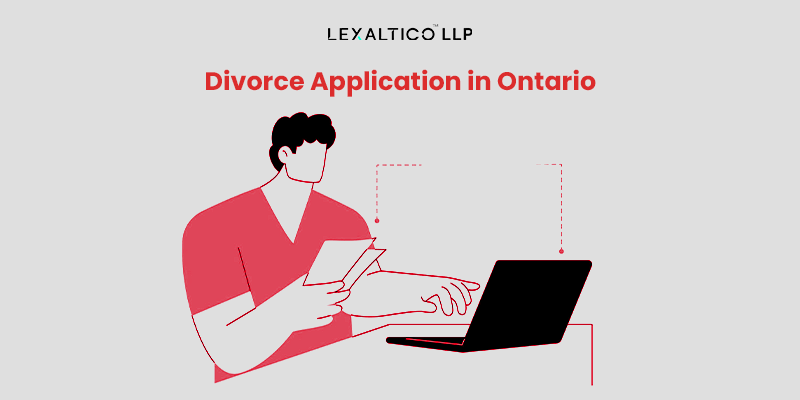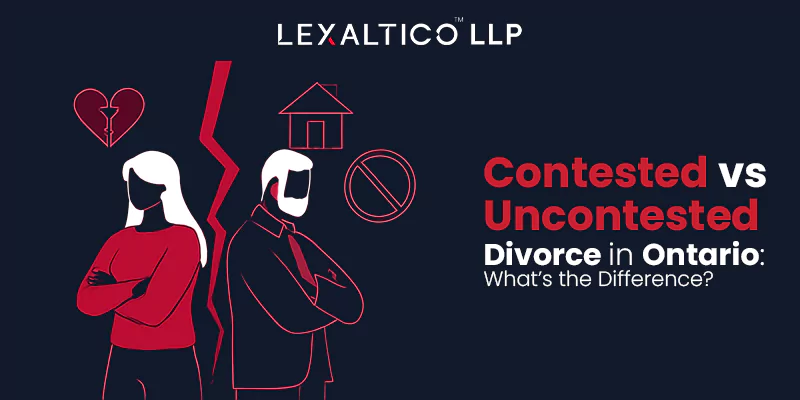Divorce is common in Ontario. According to Statistics Canada, over 40% of marriages in Canada are expected to end in divorce before the 30th year. In Ontario alone, thousands of couples file for divorce each year.
If you’re going through one, it’s important to understand your options. Divorce is not the same for everyone. The type of divorce you go through depends on whether you and your spouse agree on things like child care, support, and property.
Types of Divorce in Ontario
There are three main types of divorce in Ontario:
- Joint Divorce
- Simple Divorce
- Contested Divorce
How the Divorce Process Works in Ontario

The type of divorce you go through can change how long it takes and how much it costs. Each type follows a different process.
Joint Divorce
A joint divorce happens when both people agree to end the marriage. They also agree on things like who takes care of the children, how property is split, and who pays support. Since both sides agree, this type of divorce is often faster and easier.
Simple Divorce
A simple divorce is started by one person. This person files the divorce papers. If the other person does not respond or challenge it, the divorce moves ahead without a fight. It becomes what’s known as an uncontested divorce.
Contested Divorce
A contested divorce happens when the other person disagrees. They might want different terms for custody, money, or property. This kind of divorce can take more time and may need a court to decide.
Difference Between Contested and Uncontested Divorce in Ontario
It is important to understand whether your case is contested or uncontested, as defined by Divorce Act and Ontario family law system.
Uncontested Divorce
An uncontested divorce is often the most straightforward and cost-effective option. In this scenario, both parties agree on all aspects of the separation, including property division, child custody, and support.
The cost of an uncontested divorce in Ontario is generally lower, and the process is faster compared to contested divorces.
If you both want to move on and avoid long delays, this option works well.
Contested Divorce
A contested divorce happens when one or both people do not agree on some issues.
For example, they may not agree on child custody, who keeps the house, or how much support should be paid.
When there is no agreement, the case can go to court. This makes the process longer and more expensive. Here’s how it works:
- Filing the Application
One person files a divorce application using Form 8. - Response
The other person files an Answer (Form 10) to say what they disagree with. - Case Conference
This is the first court meeting. A judge talks with both sides to see if they can settle. - Settlement Conference
A more detailed meeting to try and reach an agreement. - Trial
If no deal is made, the case goes to trial. A judge makes the final decision.
Contested divorces can take months, or even years, to finish. They also cost more because of lawyer fees, court time, and long delays.
Grounds for Divorce in Ontario
Under the Divorce Act, there are three recognized grounds for divorce in Canada:
- Separation: Living apart for at least one year.
- Adultery: One spouse has engaged in a sexual relationship outside the marriage.
- Cruelty: Physical or mental cruelty that makes continued cohabitation intolerable.
Most divorces in Ontario are granted on the basis of separation, as it’s often the simplest to prove.
Legal Separation vs. Divorce
It’s important to distinguish between legal separation and divorce:
- Legal Separation: Spouses live apart and may have a separation agreement outlining terms like property division and child custody. However, they remain legally married.
- Divorce: The legal termination of a marriage, allowing both parties to remarry.
A separation agreement can be a precursor to divorce, but does not end the marriage legally.
Divorce Application in Ontario

To initiate a divorce in Ontario, you must:
- Meet Residency Requirements: At least one spouse must have lived in Ontario for a minimum of one year.
- Prepare Necessary Documents: This includes the divorce application (Form 8 or 8A), marriage certificate, and any agreements related to property or children.
- File the Application: Submit the documents to the Ontario Superior Court of Justice.
- Pay Court Filing Fees: There is a fee associated with filing for divorce, which may vary depending on the case.
Divorce Process in Ontario
The divorce process in Ontario follows a set of clear steps. Whether you’re filing a simple, joint, or contested divorce, most people go through the same basic process.
Step 1: Check Eligibility
You or your spouse must have lived in Ontario for at least 12 months before applying. You also need to show that your marriage has broken down. This can be from separation, adultery, or cruelty.
Step 2: Choose the Type of Divorce
Decide if you are filing a joint application or a sole application. Joint means both of you agree on everything. Sole is when only one person applies. A sole application can become contested if the other person disagrees.
Step 3: Complete the Forms
For a simple divorce, fill out Form 8A. For a joint divorce, use Form 8. You also need your marriage certificate. If it’s not in English or French, you’ll need a translation.
Step 4: File the Application
File your papers at the Ontario Superior Court of Justice. You also pay the required court filing fees for divorce.
Step 5: Serve the Other Spouse (if it’s a sole application)
If you’re filing alone, you must serve the divorce papers on your spouse. They have 30 days to respond if they are in Canada, or 60 days if they are outside the country.
Step 6: Wait for a Response
If the other spouse does not respond, it becomes an uncontested divorce. If they file an answer and disagree, it becomes a contested divorce.
Step 7: Go to Court if Needed
In a contested case, the court may set a case conference. You might also attend settlement conferences or mediation. These steps try to solve issues before the trial.
Step 8: Get the Divorce Order
If everything is in order, the judge gives a divorce order. Your divorce becomes final 31 days after the order is made.
These steps are part of the divorce procedure in Ontario under both federal and provincial law. A good family law lawyer can help you understand the details and handle the paperwork.
Conclusion
Navigating a divorce in Ontario requires understanding the different types of divorce, the grounds upon which you can file, and the legal procedures involved. Whether pursuing an uncontested or contested divorce, it’s essential to be informed and, when necessary, seek legal advice to protect your assets in divorce.
Quick FAQs
An uncontested divorce occurs when both spouses agree on all major issues, such as property division, child custody, and support.
A contested divorce arises when spouses cannot agree on one or more key issues, requiring court intervention to resolve disputes.
Court fees are approximately $669. If you hire a lawyer, legal fees can range from $999 to $2,400, depending on the complexity of your case.
An uncontested divorce in Ontario typically takes between 4 to 6 months to finalize in Ontario.
You can file for an uncontested divorce without a lawyer in Ontario. You will need to complete and file the necessary forms and pay the required court fees.
You should consider hiring a divorce lawyer in Ontario if there are disputes over child custody, support, or property division, or if you want to ensure your rights and interests are protected throughout the divorce process.
You can handle your own uncontested divorce in Ontario. This involves completing and filing the required forms, serving documents to your spouse, and paying court fees.
A separation agreement is not legally required for an uncontested divorce in Ontario.
While it’s possible for both spouses to consult the same lawyer for information, it’s generally not recommended. Lawyers have a duty to represent their client’s best interests, and representing both parties can lead to a conflict of interest.
The documents required for an uncontested divorce in Ontario include: Application for Divorce, Original marriage certificate, Affidavit of Service and Divorce, Divorce Order, and any separation agreements or financial statements, if applicable.
Your divorce is uncontested if both you and your spouse agree on all major issues. If your spouse disagrees with any terms or files a response challenging the application, the divorce becomes contested.
Disclaimer: The information provided in this blog is for general informational purposes only. It is not legal advice and should not be relied on as such.



